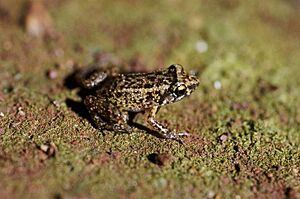Greenhouse frog facts for kids
Quick facts for kids Greenhouse frog |
|
|---|---|
 |
|
| Conservation status | |
| Scientific classification | |
| Synonyms | |
|
The greenhouse frog (Eleutherodactylus planirostris) is a small type of frog. It naturally lives in places like Cuba, the Bahamas, and the Cayman Islands. But it has also been carried by people to new places such as Florida, Hawaii, and Guam.
What Does It Look Like?
The greenhouse frog is a tiny frog. It grows to be about 17 to 31 millimeters long. That's less than an inch! These frogs are usually dull brown or olive green. They can look a bit different from each other. Some have two wide stripes going down their back. Others have a spotty or "mottled" pattern. Their bellies are lighter in color than their backs. A cool fact about them is that they have red eyes!
Where Do They Live?
Greenhouse frogs are originally from Cuba and other islands in the West Indies. People have accidentally moved them to new places. Now, they are common in Hawaii and Florida. They have also been seen in parts of Georgia, Alabama, and Louisiana. You can also find them in Jamaica, Guam, and Shenzhen, China. These frogs like damp places. They often live in wet leaf litter, especially near homes. You might not see them much because they are nocturnal, meaning they are active at night. Sometimes, they come out on warm, rainy days in summer. In Florida, some have been found hiding in trees during March.
What Do They Eat?
The greenhouse frog eats small bugs and other tiny creatures. Their diet includes things like ants, beetles, mites, spiders, and roaches.
Reproduction and Life Cycle
Greenhouse frogs are special because they don't lay their eggs in water. Unlike many frogs, their eggs are not in a foamy mass either. Instead, their eggs are covered in a thick layer. They lay them one by one in hidden, damp spots. This could be under a log, buried in leaves, or even under a flower pot. In Florida, a female frog can lay between 3 and 26 eggs at a time. The baby frogs develop inside the egg. They skip the tadpole stage that happens in water. When they hatch, they are already tiny frogs! They are about 5 millimeters long and have a short tail. This tail soon disappears. If it's warm, the eggs can hatch in about 13 days. The baby frogs have a special "egg tooth" on their snout. This helps them break out of the egg case. After hatching, they don't need it anymore, so it falls off. Sometimes, the adult frog might stay near the eggs. This suggests they might guard their eggs to keep them safe.


